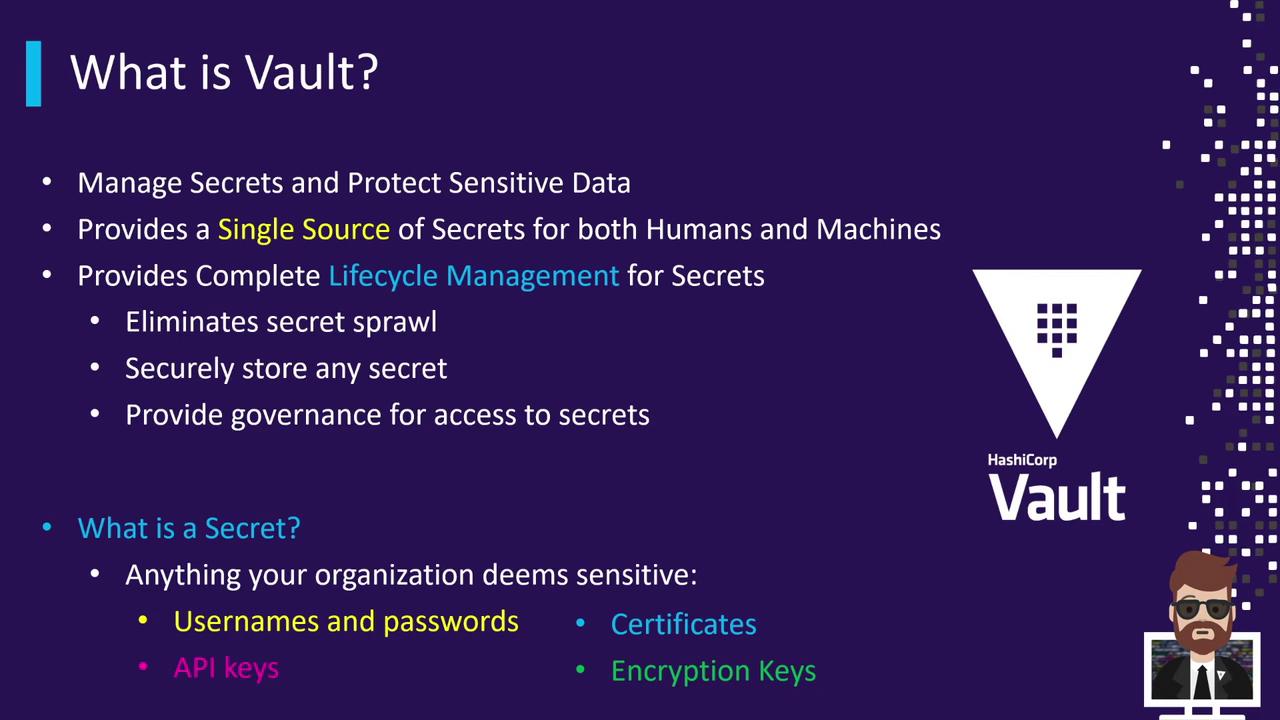HashiCorp Certified: Vault Associate Certification
Introduction to Vault
What is Vault
Welcome to this lesson on HashiCorp Vault, the industry-standard solution for secure secrets management. Here, you’ll gain foundational knowledge to operate Vault with confidence.
Lesson Objectives
By the end of this lesson, you will be able to:
- Describe how Vault integrates into the HashiCorp ecosystem
- Explain Vault’s core features, architecture, and benefits
- Identify common Vault use cases and deployment scenarios
- Compare Vault Open Source vs. Enterprise editions
- Download and install Vault using various methods
Vault in the HashiCorp Ecosystem
HashiCorp offers eight open source tools—four of which also provide Enterprise editions with advanced features like high availability and enterprise support. Vault plays a critical role in securing secrets across your infrastructure automation workflows.
| Product | Open Source | Enterprise Available | Primary Use Case |
|---|---|---|---|
| Terraform | ✓ | ✓ | Infrastructure as Code |
| Consul | ✓ | ✓ | Service Discovery & Networking |
| Nomad | ✓ | ✓ | Workload Orchestration |
| Vault | ✓ | ✓ | Secrets Management & Data Protection |
| Vagrant | ✓ | ✗ | Development Environment Automation |
| Packer | ✓ | ✗ | Machine Image Build Automation |
| Boundary | ✓ | ✗ | Secure Remote Access |
| Waypoint | ✓ | ✗ | Application Deployment Automation |
Vault integrates seamlessly with Consul for storage backends and with Terraform for provisioning secure infrastructure.
What Is Vault?
Vault is a secure system for storing, managing, and controlling access to secrets—any data that must remain confidential. Common secret types include:
- User credentials (usernames and passwords)
- API keys and tokens
- TLS certificates and encryption keys
Vault as a Single Source of Truth
Vault centralizes secrets for both humans (CLI/UI) and machines (API), ensuring consistent and secure access across your organization.
Key Features
Comprehensive Secrets Management
Vault treats each piece of sensitive data—passwords, tokens, certificates—as a “secret,” providing a unified storage and retrieval interface.Dynamic Secrets & Lifecycle Automation
- Generates dynamic, short-lived credentials (e.g., database credentials, cloud access tokens).
- Automates secret leases: issuing, renewing, and revoking secrets.
- Limits blast radius by ensuring compromised secrets expire rapidly.
Elimination of Secret Sprawl
Vault’s dynamic approach reduces the need for static, long-lived credentials scattered across servers or code repositories.Secure Storage for Static Credentials
For cases where long-lived secrets are unavoidable, Vault offers encrypted backend storage, replacing insecure methods like plaintext files.Fine-Grained Access Control
Policies define which users or machines can access specific secrets, enabling strict isolation between teams and applications.

In the upcoming sections, we will cover:
- Why organizations adopt Vault
- Real-world Vault use cases
- Vault editions: Open Source vs. Enterprise
- Vault architecture deep dive
- Downloading and installing Vault (binary, package manager, Docker)
Let’s continue to explore the power and flexibility of HashiCorp Vault.
Links and References
Watch Video
Watch video content